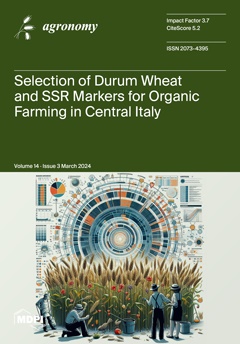Ver ítem
- xmlui.general.dspace_homeCentros Regionales y EEAsCentro Regional Tucumán - Santiago del EsteroEEA FamailláArtículos científicosxmlui.ArtifactBrowser.ItemViewer.trail
- Inicio
- Centros Regionales y EEAs
- Centro Regional Tucumán - Santiago del Estero
- EEA Famaillá
- Artículos científicos
- Ver ítem
Trichopria anastrephae: A Promising Neotropical-Native Parasitoid for Drosophila suzukii Control
Resumen
Drosophila suzukii (Matsumura) is an invasive pest mainly affecting berry and stone fruit crops worldwide. In Argentina, it inhabits fruit-growing regions. An eco-friendly management strategy involves biological control by using resident natural enemies, such as the Neotropical-native pupal parasitoid Trichopria anastrephae Lima (Ta). The study compared the host-killing capacity and the offspring reproductive success of two Ta lineages on the puparia of
[ver mas...]
Drosophila suzukii (Matsumura) is an invasive pest mainly affecting berry and stone fruit crops worldwide. In Argentina, it inhabits fruit-growing regions. An eco-friendly management strategy involves biological control by using resident natural enemies, such as the Neotropical-native pupal parasitoid Trichopria anastrephae Lima (Ta). The study compared the host-killing capacity and the offspring reproductive success of two Ta lineages on the puparia of both D. suzukii (Ds) and D. melanogaster (Dm) in no-choice and choice tests under laboratory conditions. The host preference and host-switching behaviors were also assessed. One parasitoid lineage was reared on Ds (TaDs), and the second on Dm (TaDm). In no-choice tests, both Ta lineages performed similarly on both hosts regarding the percentage of killed hosts and parasitoid offspring survival. The host-killing ability of TaDm was only significantly lower when Ds was offered as a host, relative to Dm. In choice tests, Ta attacked mainly Ds at a 4–9 times Ds to Dm ratio, but at a 1.5–2 times Ds to Dm ratio, the host-killing ability was similar between both drosophilids. At an equal host ratio or higher Dm ratios, Ta preferred the native host. However, it was determined that Ta has the potential to parasitize the recently-introduced pest.
[Cerrar]

Autor
Buonocore Biancheri, María Josefina;
Suárez, Lorena del Carmen;
Núñez-Campero, Segundo Ricardo;
Ponssa, Marcos Darío;
Garcia, Roberto Mello;
Kirschbaum, Daniel Santiago;
Ovruski Alderete, Sergio Marcelo;
Fuente
Agronomy 14 (3) : 520. (March 2024)
Fecha
2024-03
Editorial
MDPI
ISSN
2073-4395
Formato
pdf
Tipo de documento
artículo
Palabras Claves
Derechos de acceso
Abierto
 Excepto donde se diga explicitamente, este item se publica bajo la siguiente descripción: Creative Commons Attribution-NonCommercial-ShareAlike 2.5 Unported (CC BY-NC-SA 2.5)
Excepto donde se diga explicitamente, este item se publica bajo la siguiente descripción: Creative Commons Attribution-NonCommercial-ShareAlike 2.5 Unported (CC BY-NC-SA 2.5)
Metadatos
Mostrar el registro completo del ítem
Excepto si se señala otra cosa, la licencia del ítem se describe como info:eu-repo/semantics/openAccess
Ítems relacionados
Mostrando ítems relacionados por Título, autor o materia.
-
Manejo de malezas en el cultivo de pecán
Taiariol, Dario (EEA Bella Vista, INTA, 2022-12-15)Una planta no deseada en un lugar no deseado. No siempre invasivas o salvajes. Efectos adversos de malezas. -En plantas jóvenes: Compite y afecta la disponibilidad de nutrientes, luz y agua y, además, alelopatías. - En ... -
Taladrillo de los forestales: algunos aspectos de su biología, detección y manejo de poblaciones
Cichon, Liliana; Garrido, Silvina Alejandra; Lago, Jonatan; Ahmad, Samir (EEA Alto Valle, INTA, 2013)Megaplatypus sulcatus Chapius, conocido vulgarmente como "barreno" o "taladrillo de los forestales", es un coleóptero que produce severos daños en plantaciones forestales y frutales perforando el tronco de los árboles, ... -
Insectos de importancia económica y sanitaria La chinche del arce, Boisea trivittata: una nueva especie establecida en la Patagonia
D’Hervé, Federico; Fernández, Celeste (EEA Bariloche, INTA, 2025-07)La chinche del arce, una especie exótica originaria de América del Norte, ha sido detectada recientemente en el norte de Neuquén. Este insecto se alimenta principalmente de las semillas del arce, un árbol ornamental frecuente ...


